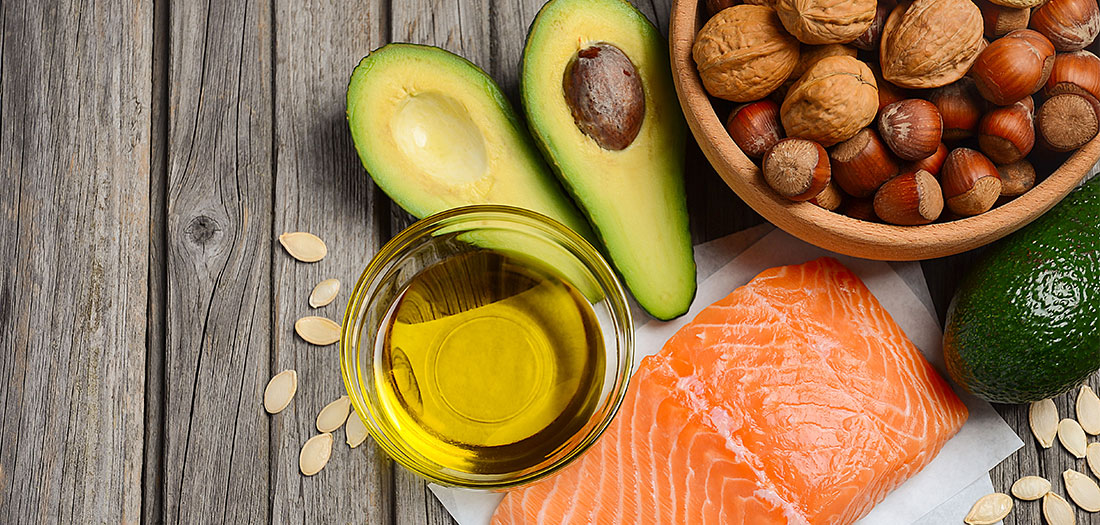ACE Fit Life
Fat: Friend or Foe? And How Much Should You Eat?
February 23, 2017

For years we were told that eating fat would make us fat and increase our risk for heart disease. But now we’re told that the old recommendations were incorrect and we should be eating fat with every meal. So, who’s right? Well, it’s not a cut-and-dry answer. Let’s separate the fat facts from fiction to figure out how much each of us really should be eating.
In the late 1970s, there was a spike in sudden death from heart attacks and new legislation was passed creating the first set of dietary guidelines for Americans. We were told to decrease our intake of fat because fat increased cholesterol levels, which would increase the risk of a heart attack. As a result, the 1980s and 1990s saw the boom of the “fat-free” movement, and fat-free cookies, cakes and crackers flooded the market shelves. Pasta, rice, pretzels and bread became the focus of the diet because they contained no fat. People shunned olive oil, butter, nuts and avocados because they were high-fat foods. But instead of lower rates of heart disease, we saw an increase in obesity, type 2 diabetes and heart disease. How could this happen?
High-carbohydrate diets, especially carbohydrates from processed foods, cause an increase in insulin production that can lead to fat storage and inflammation. Numerous studies over the past two decades that have compared high-fat/low-carb diets with low-fat/high-carb diets have consistently found that lower-carb/higher-fat diets promoted more weight loss and better lipid profile numbers. Population studies of people who consume higher-fat diets, such as the Mediterranean and France (French Paradox) approaches to eating, as well as numerous tropical regions, have shown lower rates of heart disease, obesity and Alzheimer’s disease. These diets also are high in fruits and vegetables and have little-to-no processed food.
FUNCTIONS AND BENEFITS OF FAT
Fat is one of three macronutrients (protein and carbohydrates are the other two). All fat contains 9 calories per gram, making it very energy-dense. Fat has many important functions in the body, including:
- Energy
- Hormone production – sex hormones, steroid, and cholesterol
- Brain function and mood
- Absorption of fat-soluble vitamins – vitamins A, D, E and K
- Flavor – fat carries flavor and provides mouth-feel that improves meal satisfaction
- Satiety – fat takes longer to digest than carbohydrates, so you feel fuller for longer
TYPES OF FAT
Fat can be divided into different types based on their chemical structure. Most foods contain a combination of these different fats, with one being the predominant type.
MONOUNSATURATED FATS (MUFAs)
Monounsaturated fats are liquid at room temperature and can hold up well under high temperatures. Found commonly in avocados, olive oil and almonds, MUFAs get a big “thumbs up,” as numerous studies have linked diets high in MUFAs with reduced risk of heart disease and diabetes.
POYLUNSATURATED FATS (PUFA)
Also liquid at room temperature, PUFAs are a large category of fats that are better understood when further split into two groups: omega-3s and omega-6s.
OMEGA-3 fats are known to be anti-inflammatory and associated with lower risk of heart disease, diabetes, depression and obesity. Foods rich in omega-3s include wild Alaskan salmon, mackerel, sardines anchovies, herring, chia, flax and walnuts. The two important forms of omega-3s are EPA (eicosapentaenoic acid) and DHA (docosahexaenoic acid) and are found in fatty fish. Plant forms of omega-3s contain ALA (alpha linoleic acid), which has to be converted to EPA and DHA in the body. Unfortunately, this conversion is a slow process, but even so, plant-rich omega-3s, such as chia and flax seed, are high in fiber, lignans (a cancer-reducing type of fiber) and protein and should be consumed regularly.
OMEGA-6 fats are found widely in nut and seed oils and many processed foods commonly eaten in a Western diet. These fats can become pro-inflammatory when consumed in excess (as in a typical diet) and when omega-3 intake is low. The ideal ratio of omega-3s to omega-6s in the diet is 1:1 to 1:4. However, the standard American diet (SAD) has a ratio of 1:20 or greater! With a diet like this, it’s no wonder that chronic systemic inflammation plagues so many people.
SATURATED FATS
Saturated fats are solid at room temperature and stable at high temperatures. Found in foods such as butter and lard, saturated fats can raise LDL (“bad” cholesterol”) but also raise HDL (“good” cholesterol). Once thought to be a major cause of increasing one’s risk for heart disease, saturated fats are now considered neutral in terms of their impact on health. Coconut oil, which is a saturated fat and high in medium chain triglycerides (MCT), is favored for its heart and brain benefits.
TRANS FATS
Although some trans fats occur naturally in dairy and other animal food, most are artificially produced and can be identified on a food label by the words, “partially hydrogenated vegetable oil.” Trans fats are commonly found in processed foods because they can help extend the shelf life of food. These fats are the most dangerous to consume as they increase inflammation, cause multiple alterations in lipid levels, affect arterial function, increase insulin resistance and promote excess belly fat. There is no recommended level for trans fats and should be avoided.
SO HOW MUCH FAT SHOULD YOU EAT?
More important than quantity is the quality of fats you consume. Adding MUFAs, omega-3 PUFAs and/or MCT-rich coconut oil to every meal will ensure that you are getting enough of the right kinds of fat. Including fat at each meal will help you to feel fuller for longer, balance blood sugar level, and increase your satisfaction with each meal. Cook with virgin coconut or olive oil, add chia or ground flax seeds to smoothies or yogurt, spread mashed avocado on your sprouted grain toast, or snack on a mix of almonds, walnuts and pecans.
There’s no single recommended amount of fat to consume. How much you need depends on your calorie requirements for weight loss, gain, or maintenance as other health conditions you may have. The American Heart Association recommends a diet containing 20-35% of calories from fat. The Mediterranean diet usually averages 35-40% fat. A Ketogenic (low-carb/high-fat) diet clocks in at 50-75% of calories from fat. So many different recommendations can be confusing.
We have found that it takes a little experimentation to determine how much fat works best for each person. Just know, that when you increase fat intake, you need to decrease calories from another macronutrient so that you stay in energy balance to prevent weight gain (unless weight gain is your goal). Usually, we recommend that refined and processed carbohydrates be swapped for healthy fats.
For an idea of how much fat you should consume, we recommend the following calculation:
|
For example, using this calculation, the recommended fat intake for a 150-pound person is 60-75 grams of fat per day.
THE BOTTOM LINE
Fat is involved in many vital functions in the body and is one of three macronutrients that must be eaten each day for optimal health. Choosing high-quality fats is of primary importance and the total amount of fat you consume ultimately depends on your weight and health goals.


